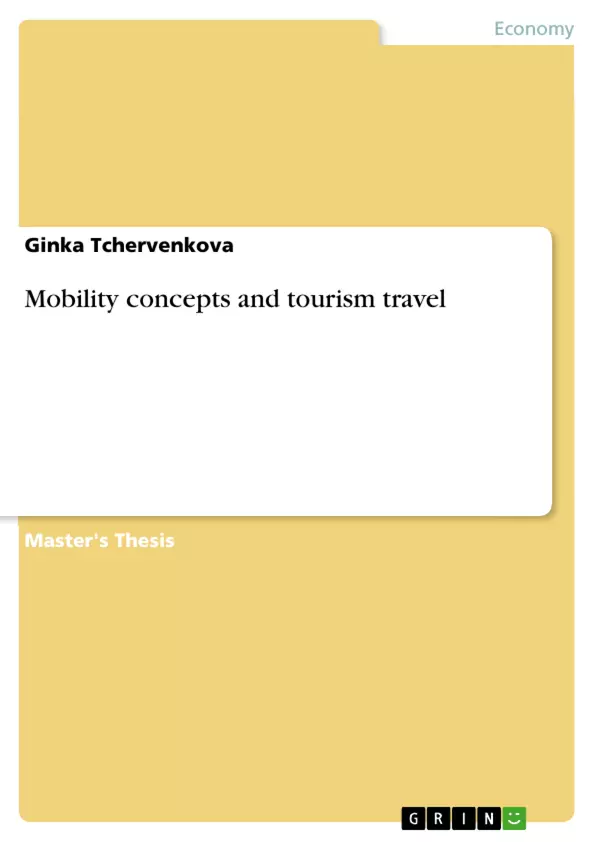Tourism development forecasts promise a continuing growth of the industry also in the future. At the same time, some academic and business circles begin to question more often whether the economic growth is a sustainable proposition and start to draw increasing attention to some aspects of the development, like the growing mobility and the environmental and capacity problems resulting from it. On one hand tourism creates or strongly contributes to their deepening, on the other hand these problems can have a reverse impact on its growth – not least because the very nature of tourism consists in the movement of people. These concerns raise the consideration to what extent the optimistic predictions for future tourism growth are realistic.
The mobility issues are especially urgent in Europe, as it has a relatively small physical size and a leading position in the world tourism travel. The disinterest of European hotel and tourism establishments to the changes in travel mobility, the quite recent appearance of new mobility concepts and processes, and the lack of sufficient publications and studies on them, convert this dissertation into a grounding work in tourism analysis.
The dissertation aims at answering the question about the impact of the new mobility concepts on the European tourism growth. In regard to that issue, it focuses on opposing the signals and perceptions from two information sources that are different in their nature but closely interrelated – the literature and the real world. It then identifies the areas of information overlapping and the place that has been assigned to the mobility concepts in the context of tourism. As a logical finalisation at the end, a discussion follows about the implications of the new mobility concepts for the European tourism industry. Through undertaking a grounding approach in the study of mobility and through the integration of this new area into tourism research, it became possible to identify the dimensions and issues in which the conducting of further and deeper research is highly recommendable. The dissertation draws conclusions about the impact of the new mobility concepts on the future tourism growth in Europe. In this way, it represents an initial attempt to fill the existing gap in tourism research – the gap called ‘mobility’.
Inhaltsverzeichnis (Table of Contents)
- CHAPTER 1, INTRODUCTION..
- 1.1. Travel & Tourism growth – an indicator for further development...
- 1.2. Problems arising from Travel & Tourism growth and their urgency - definition of the research area...
- CHAPTER 2, METHODOLOGY.
- CHAPTER 3, MOBILITY, ITS DIMENSIONS AND INTERPRETATIONS (LITERATURE REVIEW)....
- 3.1. Perceptions of the relationship tourism ✡ mobility.
- 3.2. The environment as a cross-point of phenomena tourism mobility
- 3.3. Congestion in the configuration tourism mobility..
- 3.4. The relationship tourism mobility in the literature a summary..
- CHAPTER 4, SIGNALS FROM THE REAL WORLD...
- 4.1. Perceptions of the relationship tourism ✡ mobility..
- 4.2. The environment as a cross-point of phenomena tourism ❖ mobility..
- 4.3. Congestion in the configuration tourism ✡ mobility..
- 4.4. The relationship tourism mobility in the real world – a summary.
- CHAPTER 5, DISCUSSION AND CONCLUSION..
Zielsetzung und Themenschwerpunkte (Objectives and Key Themes)
This dissertation aims to analyze the impact of new mobility concepts on the growth of the European tourism industry. It compares information from two different but related sources: academic literature and real-world observations. The dissertation identifies areas of overlapping information and analyzes the role of mobility concepts within the context of tourism. Ultimately, it explores the implications of these new mobility concepts for the European tourism industry.
- The impact of mobility concepts on European tourism growth.
- The relationship between tourism and mobility, exploring environmental and congestion concerns.
- The integration of mobility concepts into tourism research.
- The future of European tourism in light of evolving mobility trends.
- Identifying areas for further research within the field of tourism and mobility.
Zusammenfassung der Kapitel (Chapter Summaries)
Chapter 1 introduces the topic of travel and tourism growth, highlighting its significance as a driver for further development. It also discusses problems arising from this growth and defines the research area of the dissertation.
Chapter 3 provides a literature review on mobility, its dimensions, and its interpretations within the context of tourism. It examines perceptions of the relationship between tourism and mobility, the role of the environment as a cross-point of these phenomena, and the impact of congestion on this relationship.
Chapter 4 presents signals from the real world, examining perceptions of the relationship between tourism and mobility, the environment as a cross-point of these phenomena, and congestion in the configuration of tourism and mobility.
Schlüsselwörter (Keywords)
This dissertation explores the relationship between mobility and tourism, focusing on new mobility concepts and their impact on the European tourism industry. Key terms and concepts include mobility, tourism, growth, sustainability, environment, congestion, literature review, real world, and the impact of new mobility concepts on the European tourism industry.
- Citar trabajo
- Ginka Tchervenkova (Autor), 2000, Mobility concepts and tourism travel, Múnich, GRIN Verlag, https://www.grin.com/document/47221



